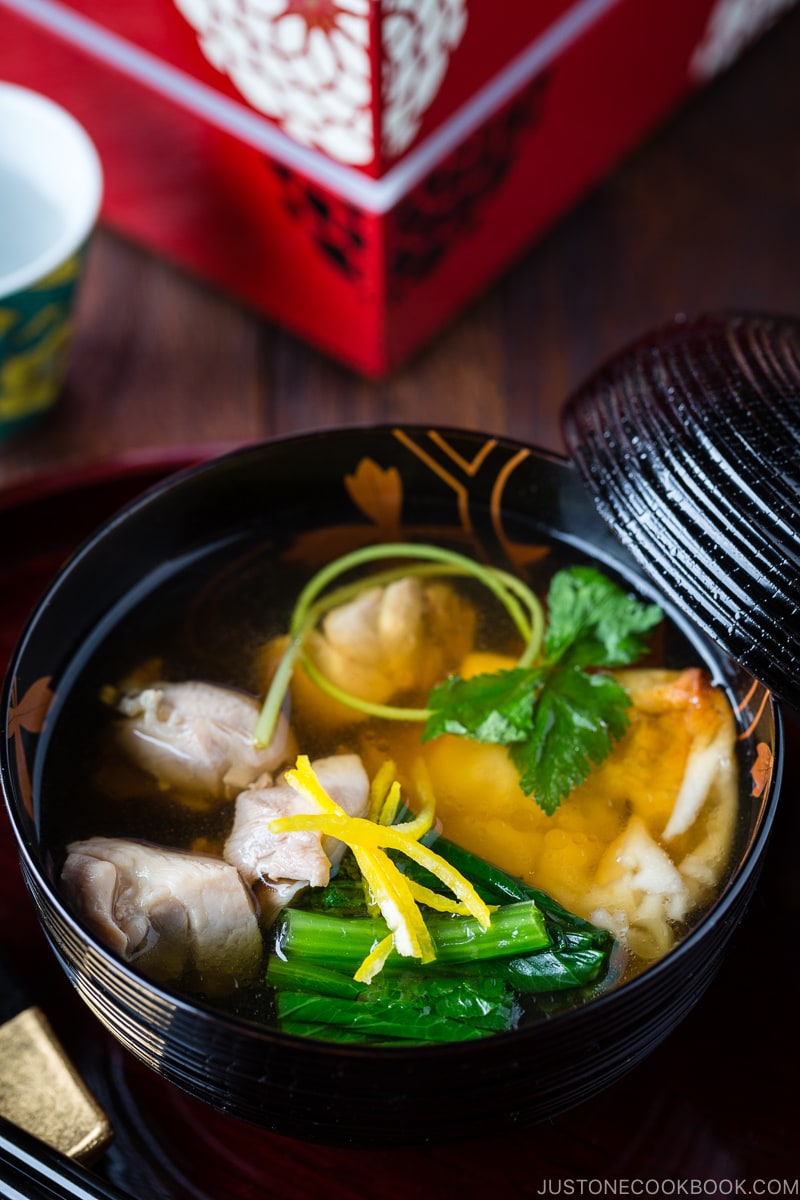
Ozoni (お雑煮) is a mochi soup that we eat along with Osechi Ryori (traditional dishes) on New Year’s Day in Japan. The preparation for ozoni varies both by household and region.
I’ve shared the Kansai (western Japan) style Ozoni recipe before, so this year I’m sharing Kanto (eastern Japan) style Ozoni.
The Kanto Style Ozoni
Unlike white miso-based Ozoni enjoyed in western Japan (Kansai, Shikoku, and Kyushu regions), clear dashi-based soup is the mainstream in Tokyo and eastern Japan (Read this post to learn some of the differences between eastern and western Japan.).
The soup includes toasted mochi, chicken, and komatsuna (小松菜) – Japanese mustard spinach, usually harvested in winter months.
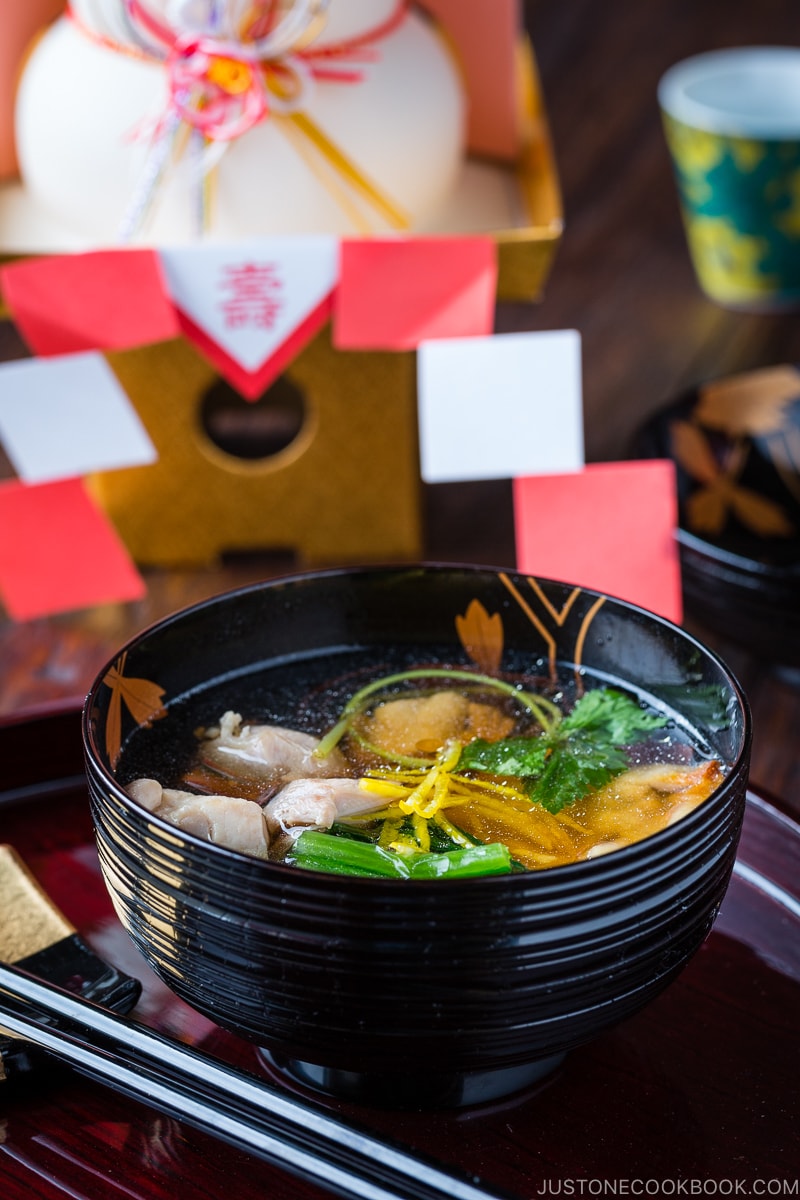
How to Make Kanto-style Ozoni
The Ingredients You’ll Need
As each family has their own recipe, there are often colorful ingredients added like fish cakes (kamaboko), dried shiitake, and the carrot that is cut out in a pretty flower shape (here’s how to make it).
Some of the key ingredients for ozoni – such as komatsuna, yuzu (citrus), and mitsuba (Japanese parsley) – can be hard to find outside of Japan and you might need to substitute or skip.
If you’re in the U.S., first check out large Japanese supermarkets like Nijiya, Mitsuwa, and Marukai, where they are usually fully stocked for New Year’s ingredients.
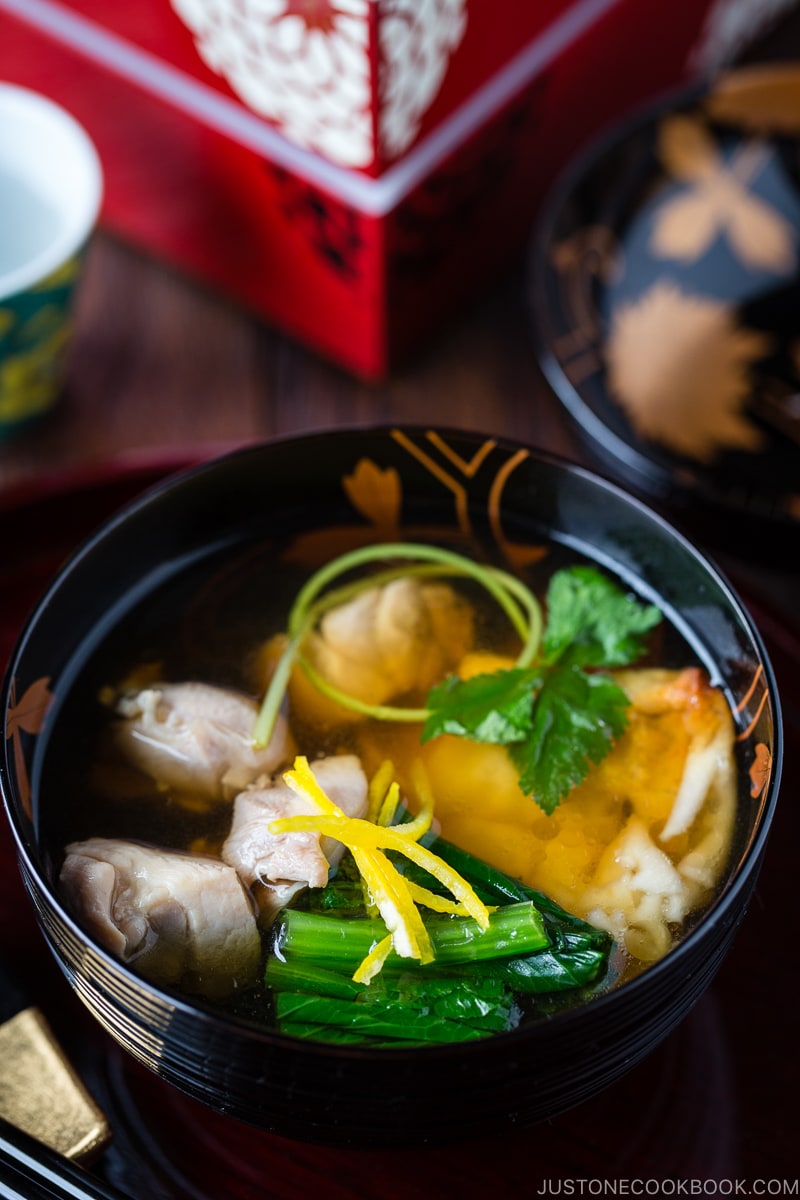
The Kansai-style Ozoni
If you’re interested in Kansai-style Ozoni with white miso, check out the video and recipe with step by step pictures.
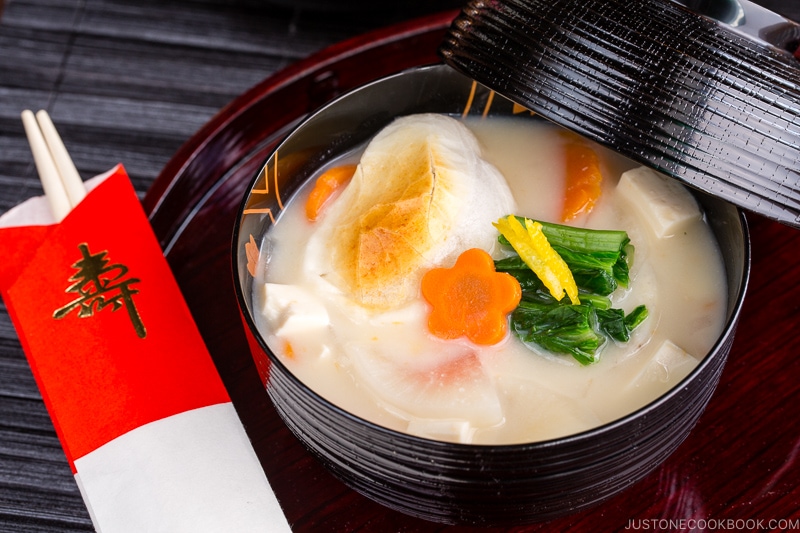
Living outside Japan, it’s hard to recreate an authentic Oshogatsu (New Year’s Day) experience; however, I do try my best to keep the Oshogatsu spirit going with Japanese New Year’s decorations around the house, otoshidama (monetary gifts), and food.
Have a happy, healthy, and prosperous New Year! 良いお年を!
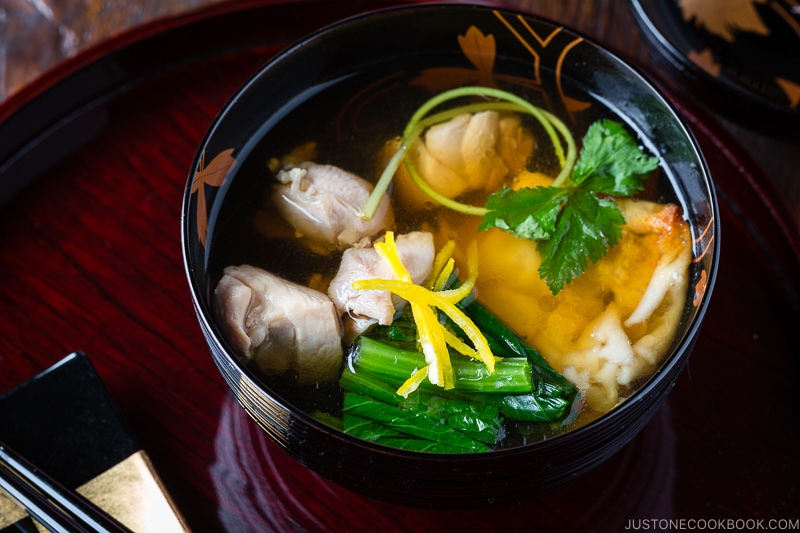
Wish to learn more about Japanese cooking? Sign up for our free newsletter to receive cooking tips & recipe updates! And stay in touch with me on Facebook, Pinterest, YouTube, and Instagram.
Ozoni (Japanese New Year Mochi Soup – Kanto Style)
Ingredients
- 1 chicken thigh (5.6 oz, 160 g; you can increase the amount if you‘d like; skip for vegetarian/vegan)
- ¼ tsp Diamond Crystal kosher salt (for the chicken)
- 1 Tbsp sake (for the chicken)
- 4 stalks komatsuna (3.5 oz, 100 g; or use spinach)
- yuzu zest (optional)
- 4 sprigs mitsuba (Japanese parsley) (optional)
- 4 pieces Japanese rice cake (kiri mochi)
For the Soup
- 4 cups dashi (Japanese soup stock) (I used Awase Dashi; you also could use a dashi packet, dashi powder, or Vegan Dashi)
- 1 Tbsp sake
- 1 Tbsp soy sauce
- 1 tsp Diamond Crystal kosher salt
Instructions
- Before You Start: Please note that this recipe calls for homemade dashi that takes a minimum of 20 minutes to make. Please see my recipe for How to Make Dashi. If you don‘t have time to make this Japanese soup stock from scratch, you can use a dashi packet or dashi powder.
- I recommend prepping this recipe the day before you plan to serve. The next day, reheat the soup and add the mochi just before serving. For more helpful tips on planning your Japanese New Year feast, please read my A 5-Day Osechi Cooking Timeline blog post.
- Gather all the ingredients.
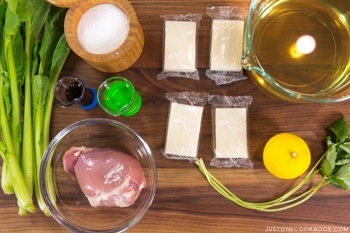
To Prepare the Ingredients
- Cut 1 chicken thigh into bite-sized pieces (1 inch, 2.5 cm) and put them in a small bowl. Then, add ¼ tsp Diamond Crystal kosher salt.
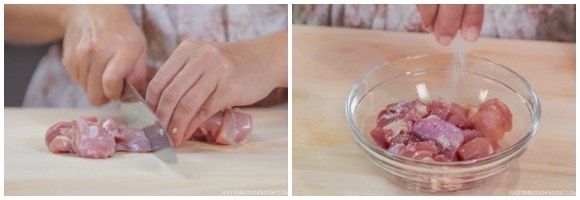
- Add 1 Tbsp sake and mix well with your hands. Let the chicken marinate for 15 minutes.
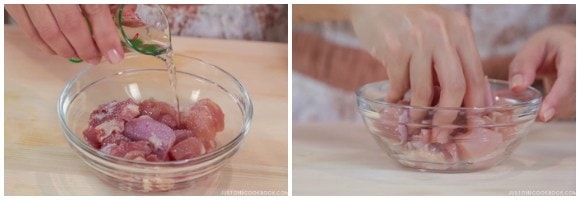
- Meanwhile, blanch 4 stalks komatsuna (or spinach) in boiling water and cook until tender (do not overcook). Remove from the pot and soak it in iced water to stop the cooking.
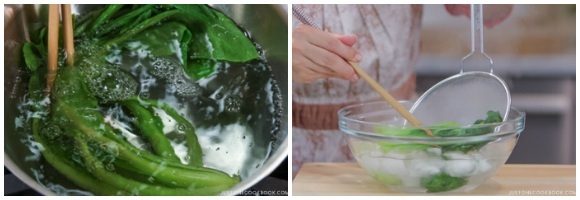
- Squeeze the water out of the komatsuna and cut it into pieces 1½ inches (3 cm) long. Set aside.
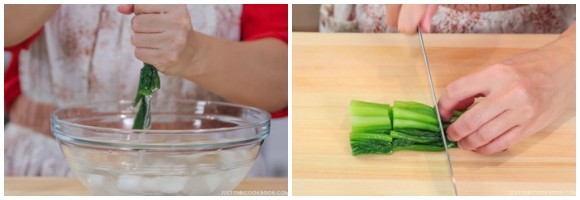
- Make a knot in the stem of each of 4 sprigs mitsuba (Japanese parsley) (optional). Set aside for garnish. Next, peel 2–3 thick strips of yuzu zest (optional).
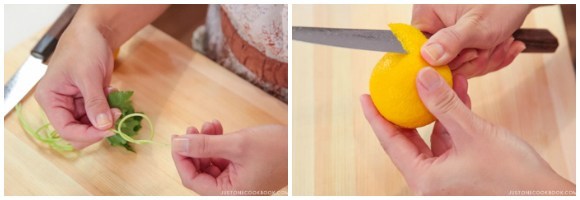
- Flip the pieces over and remove any white pith. Then, slice the strips of yuzu zest into very thin julienned strips. Place on a small dish and set aside to serve as garnish later.
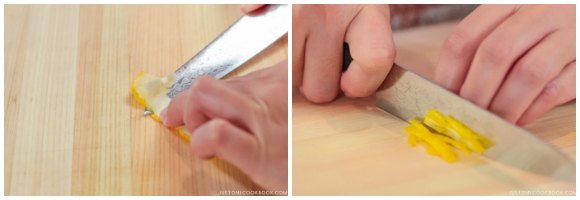
To Cook the Soup
- Add 4 cups dashi (Japanese soup stock) to a large saucepan or pot and bring it to a boil. Once boiling, add the chicken pieces.
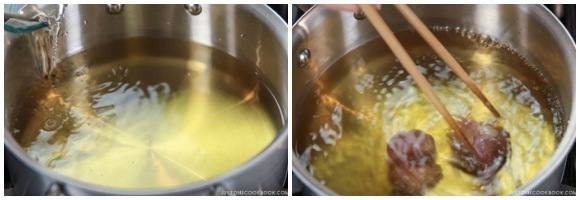
- Cover to cook for 5–7 minutes, depending on the size of the chicken pieces.
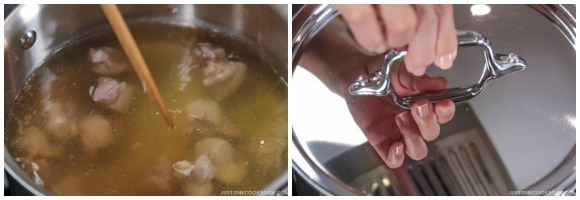
- Once the chicken is cooked, skim off the foam and fat from the surface of the soup with a fine-mesh strainer.

- Add 1 Tbsp sake, 1 Tbsp soy sauce, and 1 tsp Diamond Crystal kosher salt. Stir well and keep it covered on a simmer.

- Once the soup broth and toppings are ready, place 4 pieces Japanese rice cake (kiri mochi) directly on the rack of a toaster oven and toast until puffy. You can also toast the mochi over an open flame, under a broiler, or in a frying pan.

To Serve
- Serve the chicken and soup in individual serving bowls. Add one piece of toasted mochi on top of the soup in each bowl. Top with the komatsuna, mitsuba (optional) and yuzu (optional). Enjoy immediately.

To Store
- Remove the mochi and store the leftover soup in an airtight container or in the pot; keep in the refrigerator for up to 3 days. I recommend toasting and adding the mochi to the soup just prior to serving.
Nutrition
Did you make this recipe?
Tag @justonecookbook on Instagram so we can see your delicious creation!
Editor’s Note: This post was originally published on December 26, 2015. It’s been republished on December 25, 2023.



